Pink: The History of a Punk, Pretty, Powerful Color
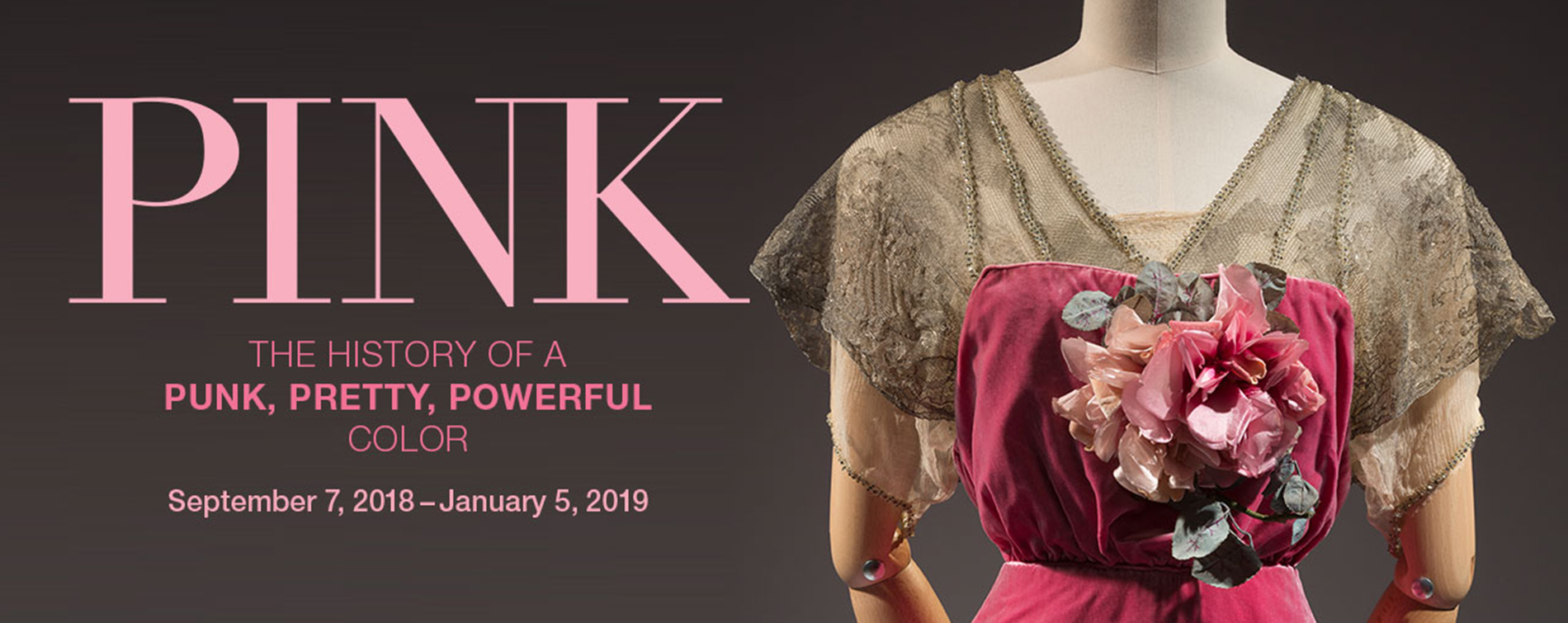
Share using #HistoryofPink on Twitter and Instagram.
Enjoy the exhibition's audio tour narrated by Dr. Valerie Steele.

Exhibit Details
Pink: The History of a Punk, Pretty, Powerful Color was organized by the museum’s director and chief curator, Dr. Valerie Steele. Pink featured approximately 80 ensembles from the 18th century to the present, with examples by designers and brands such as Elsa Schiaparelli, Christian Dior, Yves Saint Laurent, Alessandro Michele of Gucci, Jeremy Scott of Moschino, and Rei Kawakubo of Comme des Garçons. The exhibition was accompanied by a book published by Thames & Hudson and a free symposium on October 19, 2018, that was live streamed.

Céline, dress, spring 2017, France, gift of Céline, 2017.19.1
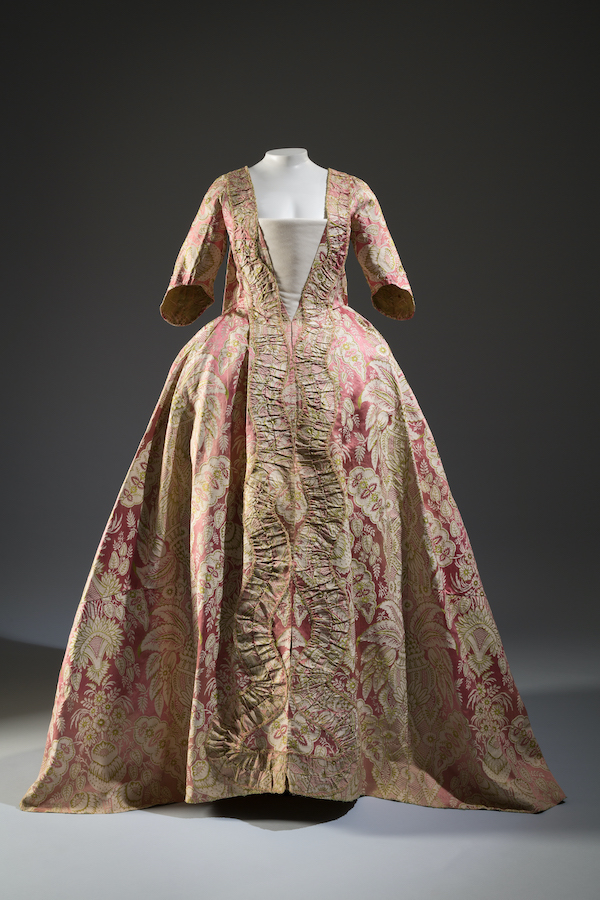
Dress, 18th century, museum purchase, 2017.46.1
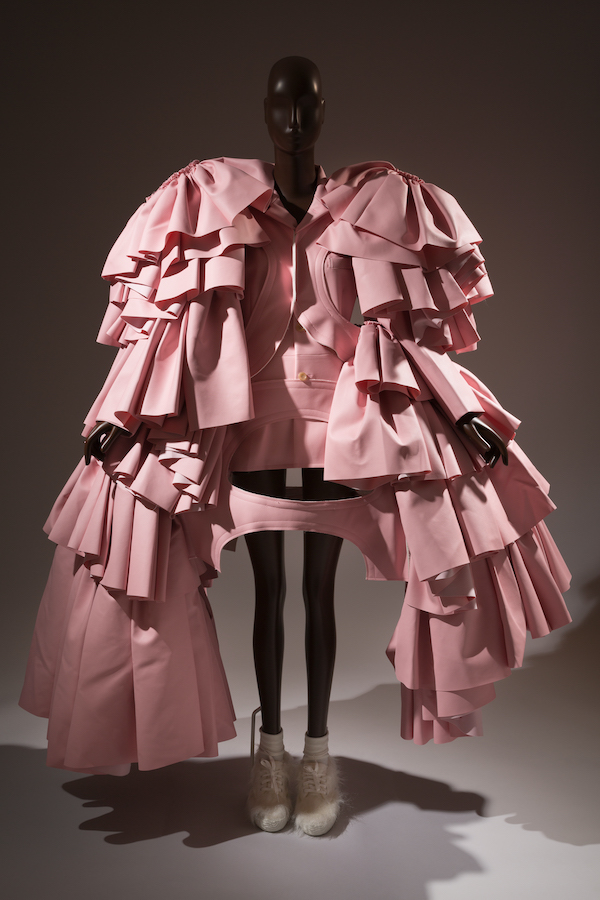
Comme des Garçons, ensemble, fall 2016, “18th-Century Punk” Collection, fall/winter 2016, Japan, museum purchase, 2017.52.1
Pink provokes exceptionally strong feelings of both attraction and repulsion. Indeed, it has been called the most divisive of colors. "Please, sisters, back away from the pink," urged journalist Petula Dvorak in The Washington Post when she learned that tens of thousands of protesters were planning to wear pink pussy hats at the Women’s March of 2017. The issues facing women are "serious," she added, and "cute" pink hats risked trivializing these issues. Yet attitudes towards pink are changing, and the color is increasingly regarded as cool and androgynous.
Although pink is popularly associated with little girls, ballerinas, and all things feminine, the stereotype of pink for girls and blue for boys only really gained traction in the United States in the mid-20th century, and the symbolism of pink has varied greatly across world history. By placing men’s, women’s, and children’s pink clothing from both Western and non-Western cultures — including India, Africa, Mexico, and Japan — in a historical context, Pink: The History of a Punk, Pretty, Powerful Color corrected popular misconceptions, encouraged viewers to question clichés and received opinion, and demonstrated that "It is society that 'makes' color, defines it, gives it meaning" — to quote the great color historian Michel Pastoureau.
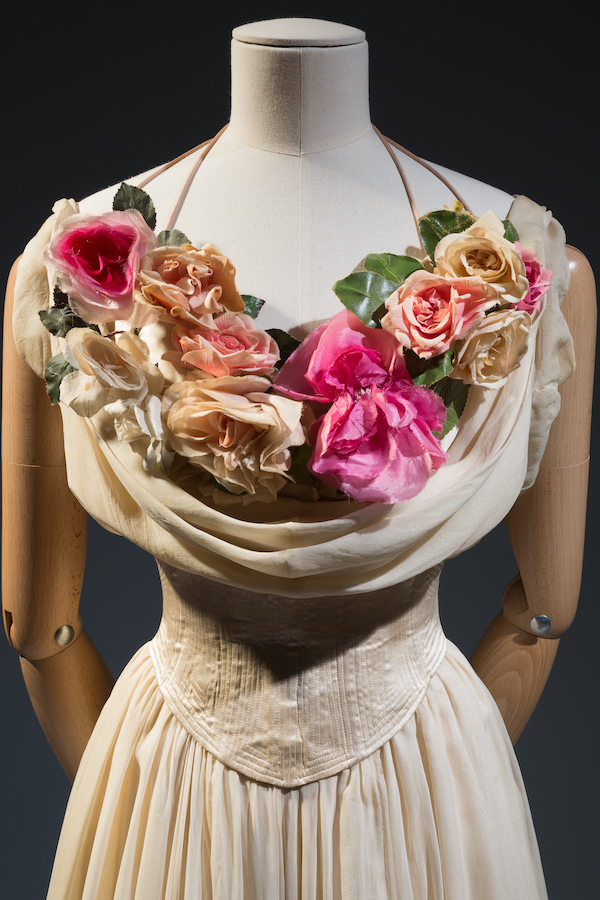
Charles James, dress, 1937, USA, gift of Mrs. John Hammond, 77.89.3
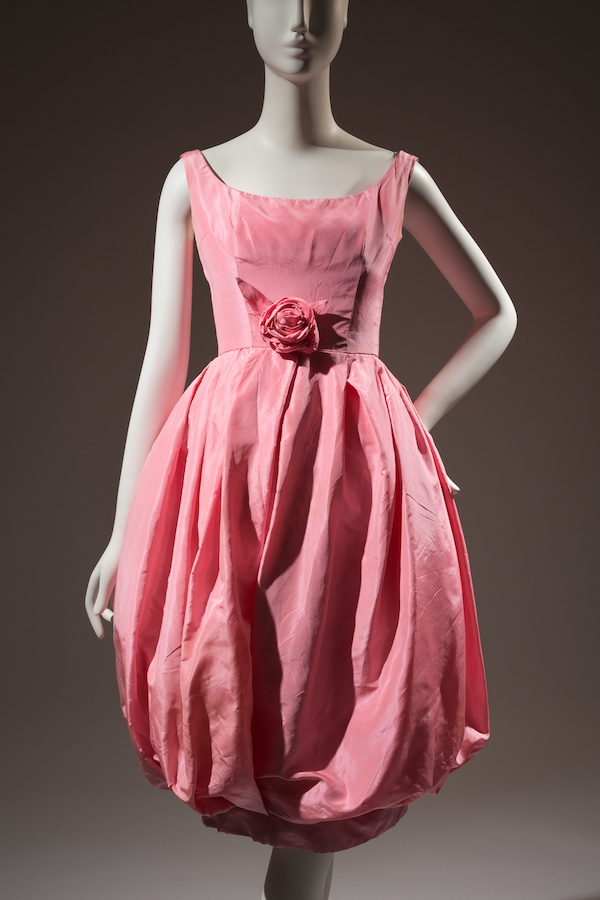
Christian Dior, dress, 1960, France, museum purchase. 2017.80.1
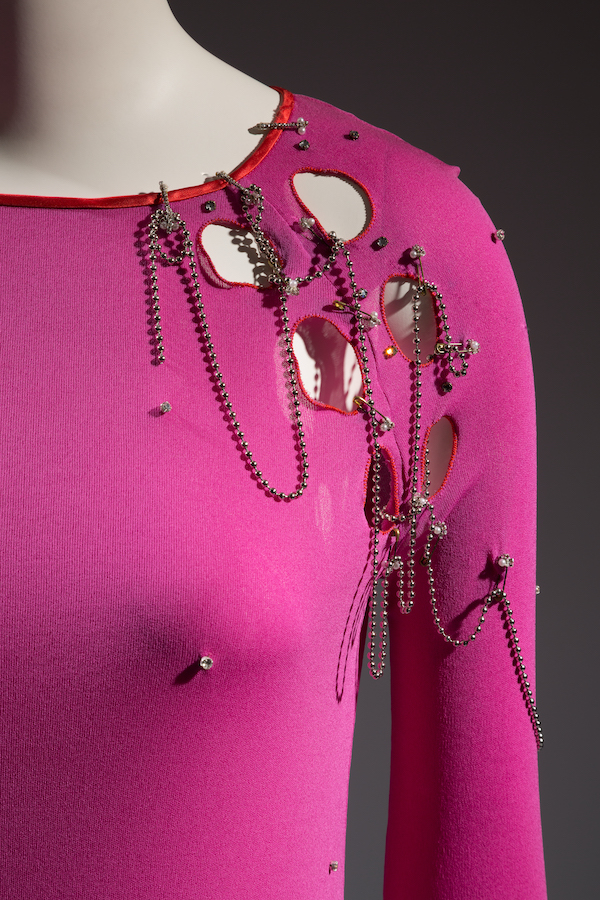
Zandra Rhodes, ensemble, 1978, England, museum purchase, 2017.7.1
The 1950s are notorious as the era of the "feminine mystique" when gender stereotyping was reinforced throughout society and the pink-for-girls, blue-for-boys gender coding took off. Naturally, there are many 1950s feminine pink dresses for girls and women, although Brooks Brothers also sold pink shirts for men. The 1960s continued to witness the popularity of many "pretty in pink" dresses, such as a 1960 cocktail dress by Yves Saint Laurent for Christian Dior. The 1970s saw a decline in pink fashion, although fluorescent pink appeared. By the 1980s, pink was back in fashion, although often, as with a 1980 hot pink "power suit" by Claude Montana, it also served to acknowledge women’s growing social authority.
In addition to the clothing and accessories that were on display, there was a fascinating diorama of pink toys and dress-up clothes for girls, dating from the 1950s to the present, including dolls, "princess" costumes, My Little Pony, and other highly gendered commodities.
In contrast to the chronological layout of the introductory gallery, the main gallery was organized thematically to highlight key concepts in the history of pink. The first section, "Pompadour Pink," featured several 18th-century ensembles, including a woman’s pink robe à la française, a man’s pink habit à la française, and a man’s pink banyan. These objects showed how pink was a new and highly fashionable unisex color in 18th-century Europe — in contrast to the 19th and 20th centuries when pink was coded as a "feminine" color. In the 18th century, pink was also important in painting and interior design.
Nearby, on the left side of the gallery, there was a small section on the pink-versus-blue gender coding in children's wear, a binary that was still in flux in the late 1920s, when opinion was divided as to whether pink was for boys or for girls. The final decision seems to have been influenced by publicity surrounding a millionaire's purchase of the paintings Blue Boy and Pinkie. Reproductions of these were featured along with that of another 18th-century painting, Pink Boy.
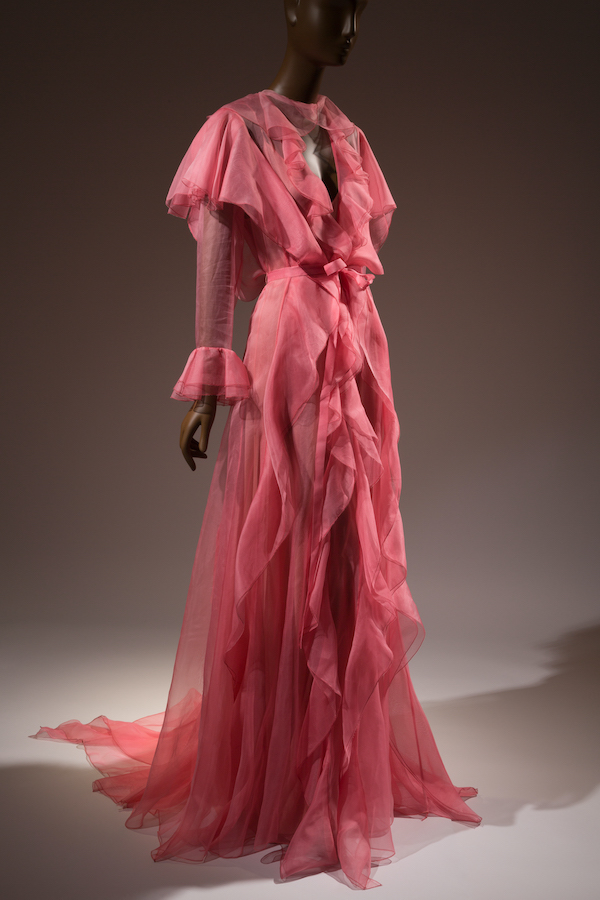
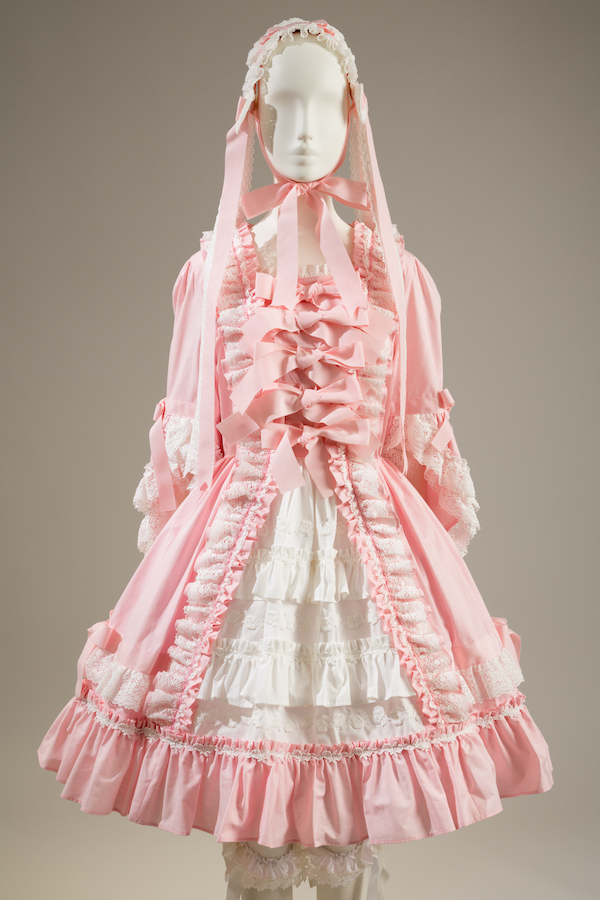
The exhibition placed pink in a global context, exploring how the color has been used in non-Western cultures. In India, for example, pink has long been worn by both men and women, while in Mexico the color Rosa Mexicano is associated with national identity. Western designers have drawn on these associations; as Diana Vreeland once said, "Pink is the navy blue of India." Schiaparelli’s Shocking Pink was explicitly associated, in her mind, with Asia and Latin America.
In the center of the gallery was a grouping of platforms, "Rose/Eros" and "Pink: The Exposed Color," that explored the erotic connotations of pink, which are both significant and overdetermined. Among the reasons why pink is widely regarded as an erotic color are the pinky-beige of Caucasian skin, which has led to the idea that pink is associated with nudity. Added to this are the fact that certain eroticized zones of the body such as the mouth, genitals, and nipples are known as "pink parts"; the fact that flowers, long associated with feminine beauty, are the sex organs of plants; and that pink-colored cosmetics are used to simulate blushing. Lingerie, corsets, and evening gowns, often produced in shades of pink, are featured in this section.
Pink has played a notable role in both political protests and popular music associated with rebellious youth. The transgressive role of pink is emphasized across several platforms featuring both men's and women's clothes, ranging from vernacular garments to avant-garde high fashion. Featured items included pink pussy hats, and looks associated with music genres ranging from punk to hip-hop.
The second gallery expanded audience perspectives on pink and showed how contemporary designers are increasingly challenging traditional ideas about sweet, pink femininity. Rei Kawakubo, the radical designer behind Comme des Garçons, has been especially influential with collections ranging from "Biker/Ballerina" to "18th-Century Punk." Even the house of Valentino has produced T-shirts asserting that "Pink Is Punk."
Publication
Pink: The History of a Punk, Pretty, Powerful Color was accompanied by a multi-author book of the same title, published by Thames & Hudson on September 4, 2018 (208 pages, 120 color illustrations, $50 hardcover). Valerie Steele authored the title essay and edited the book, which also included essays by Deborah Nadoolman Landis ("Panavision Pink: Deceptively Demure"), Cassandra Albinson ("Feminine Desire and Fragility: Pink in Eighteenth-Century Portraiture"), Regina Lee Blaszczyk ("Pink Predictions"), Dominique Grisard ("In the Pink of Things: Gender, Sexuality, and Color"), Tanya Melendez ("Mexican Rose"), and Masafumi Monden ("The Color of the Day: Many Shades of Pink in Japan").
Symposium
In conjunction with the exhibition Pink: The History of a Punk, Pretty, Powerful Color, The Museum at FIT held a symposium on October 19, 2018.
Pink: The History of a Punk, Pretty, Powerful Color was supported by the Couture Council of The Museum at FIT, Mary Kay Cosmetics, the
Coby Foundation, and the New York State Council on the Arts with the support of Governor
Andrew M. Cuomo and the New York State Legislature.
